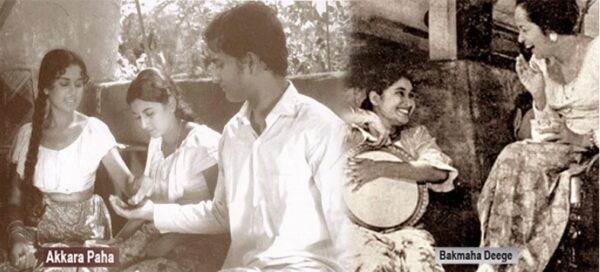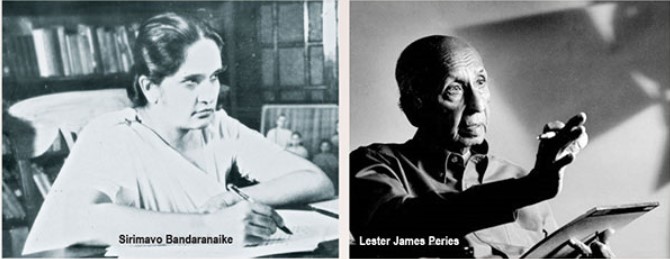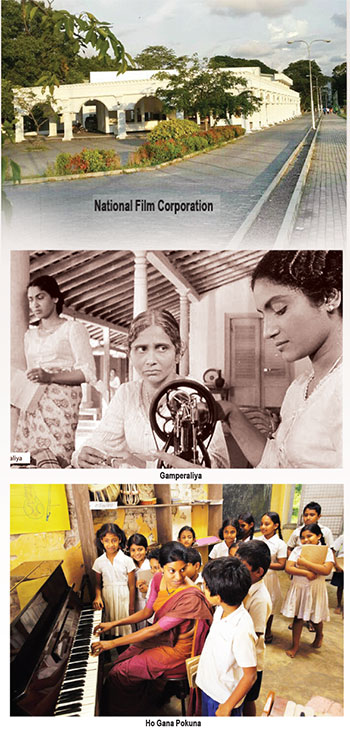The state of the art: Our cinema-By Uditha Devapriya

Source:Island
(With input from Dhananjaya Samarakoon)
In 1965 the Sri Lankan government published the findings of a Commission of Inquiry into the Film Industry. Filled with proposals and representations from prominent players in the Ceylonese cinema, the Commission made several recommendations. The most important of these was the establishment of a National Film Corporation. Though this would not come to pass until six years later, with the election of a socialist regime committed to a level playing field in the industry, the need for such an institution was frequently underscored.
Among those who made representations to the Commission was Ceylon Theatres. Admitting to the problems of the local cinema, the organisation contended that whether financed by the State or by private players, the film producer “cannot escape the limitations imposed by his audience.” Distinguishing between the cinema and the other arts, it added that while painters, playwrights, novelists, and sculptors could create without paying much regard for the reactions of the masses, the producer remained “the slave of his audience.”

Perhaps the most important point the Commission made was the link between the fortunes of the cinema and the country’s economic problems. Advocating greater intervention in the sector, the centre-left administration which took office in 1970 recognised the problems of allowing a few private players “to virtually control the local film industry.” To that end the new government sought to reduce the influence of monopolistic elements in the market, by regulating the production, distribution, and exhibition of films. Seeking superior production values and greater local output, it tried to give the cinema a new lease of life.
In 1977 the controls enforced by the Sirimavo Bandaranaike administration were loosened. The most immediate result of the new policy was, on the one hand, “ever increasing access to American and Hong Kong productions” and, on the other, the removal of “impediments for newcomers to enter the field.” In other words, from a level playing field, the industry transformed into a business venture. The introduction of television had a considerable say in the reduction of audience numbers that followed, though commentators are divided on the extent to which it led to a fall in cinema hall attendance.
Any examination of the problems and dilemmas of the Sri Lankan cinema must consider these historical developments and shifts. Rather belatedly recognising what should have been acknowledged a long time ago, the Sri Lankan State officially categorised the cinema as an industry late last year. Though this comes too little, too late, it nevertheless behoves us to consider and reflect upon the issues facing the field now, from both administrative and creative standpoints. As always, of course, the link between these issues and the country’s economic problems remains relevant, as much as it did in 1965.
Glancing through the history of the Sri Lankan cinema, from its inception in 1947, we note that the deterioration of creative standards has been rather sharp and dismal. What’s ironic is that despite such a descent, there’s no end to the courses being offered on filmmaking, acting, scriptwriting, and cinematography in the country today. We can conclude that the main contradiction here lies between an ever-fertile reserve of talent and a woeful lack of opportunity for such talent. In other words, we have enough and more talented people. But they lack the money, agency, and access to make full use of their talent.
Part of the reason, which hardly, if at all, gets mentioned by the local commentariat on the cinema, is the absence of an industrial base in the sector. It comes to no surprise that the peak of the Sri Lankan cinema should have been the 1960s and 1970s: these were years in which a flourishing artistic renaissance coincided a not insignificant industrial presence in the film sector. While State intervention became more pronounced under the United Front administration, the existence of a thriving commercial base in the industry ensured a steady stream of not just mainstream, but also artistic productions.
It’s entirely fitting, then, that the cultural revolution heralded by the general election of 1956, which saw a centre-left alliance touting the values of local art forms come to power, should face its peak in these two decades. It’s also fitting that the undisputed doyen of the Sri Lankan cinema, Lester James Peries, should not just make two masterpieces in a row – the highly literate Gamperaliya (1964) and the highly experimental Delovak Athara (1966) – but then follow them up with three further masterpieces, all done for a commercial player, Ceylon Theatres – Golu Hadawatha (1968), Akkara Paha (1969), and Nidhanaya (1970) – in this period. These were years of cultural experimentation, experimentation that benefitted from cultural sectors, especially film, being linked to an industrial framework.

Conversely, the deterioration of the cinema can be traceable to the deterioration of that industrial framework in the country. On the advice of the World Bank, Shiran Ilanperuma writes, the country’s first government “recklessly squandered foreign-currency reserves while avoiding major industrial investment.” Ilanperuma writes that by the 1960s, terms of trade had begun to shift irrevocably, “as the export of primary products and raw materials could not sustain the country’s consumption of imported manufactures.” This had a not insignificant impact on the cinema: by the late 1960s, it was becoming clear that unless the State stepped in, the Ceylonese cinema, for long dependent on an oligopoly of production companies, would collapse. This issue was what the National Film Corporation attempted to address upon its establishment in 1971, as it did over the next few years.
The implementation of swabasha, despite its obvious limitations, also had an impact on the trajectory of the cinema after the 1950s. Though reviled by the English-speaking elite, the empowerment of a Sinhalese-speaking middle-class gave rise to a bilingual intelligentsia, in turn paving the way for a bilingual cultural community. It was from this community that the likes of Dayananda Gunawardena, who gave us the finest adaptation of a French play ever turned into a Sinhalese film, Bakmaha Deege, hailed. While the deterioration of creative and intellectual standards within the population should be admitted, there is no doubt that at its heyday, the Sri Lankan cinema benefitted from a flourishing middle-class.
Today, unfortunately, despite the existence of an upward aspiring and largely Sinhalese middle bourgeoisie, prospects no longer seem good for the local cinema. In any country it is the middle-classes that produce, and reproduce, its cultural elites. In Sri Lanka, though, this community has, however one looks at it, regressed on so many levels, owing mainly to a declining economic situation. We can note the decline of standards in film and television production today, not so much in acting as in scriptwriting and camerawork. We can also note a despairing lack of imagination in films and TV serials: from predictable storylines to endless dialogues, we have come down dismally on so many fronts.
I think the problem has to do with the fact that we no longer explore new themes and issues through the cinema. If we do, we invariably create trends that are imitated and reproduced by a hundred or so other filmmakers and scriptwriters. Ho Gana Pokuna was a brilliant and a highly exceptional film, but it set a precedent for stories about impoverished village schools and idealistic teachers that continue to be filmed, even now. Aloko Udapadi sensationalised audiences and critics, but since its release five years ago we have been making million-rupee budget historical epics which look and feel despairingly predictable.
To be sure, these are hardly any problems specific to only the cinema. When was the last time a cover song didn’t make the rounds online, giving a temporary spotlight to the cover artist while popularising the original tune? When did a mainstream TV series, of which seem to be inundated with these days, not try to cut costs by way of static camera frames and endless expository dialogues? Art exhibitions, especially in Colombo, seem limited to an intellectual upper crust who can afford rental costs in the city and whose work seems not merely cut off from the world around them, but also downright indifferent to it.
We need to acknowledge that there can be no way out for the cinema here unless our cultural industries are linked to a proper industrial framework. In the 1960s, the last peak decade of the three big production companies, Sri Lanka faced an acute terms of trade and structural crisis that the State shielded the cinema from by establishing a Film Corporation and setting high artistic and administrative standards. This did not, to be sure, always work out well, but it did keep the cinema at bay during those difficult days of the 1970s. One can hardly be prudish about the liberalisation of the industry after 1977, but the fact is that the sluggish growth, and then decline, of the cinema remains very much linked to the economic and structural impasses we have been stumbling into since then.
The truth of the matter is that without a proper industrial policy and industrial base, no country’s cinema can be sustained for long. Whether from a creative or an administrative standpoint, the Sri Lankan cinema deserves much more than what it has been subjected to. But where are the policymakers and experts who can prescribe radical solutions, who can recommend an industrialisation plan that can help our cinema take off? In the US, in China, and in India, these problems have been, and are being, combated. In Sri Lanka this does not appear to be the case. That is to be regretted, deeply and sincerely.
(Uditha Devapriya can be reached at udakdev1@gmail.com, while Dhananjaya Samarakoon can be reached at dhananjayasmrk@gmail.com)







